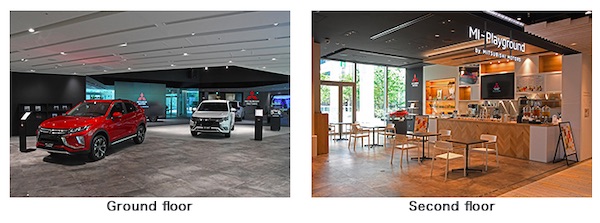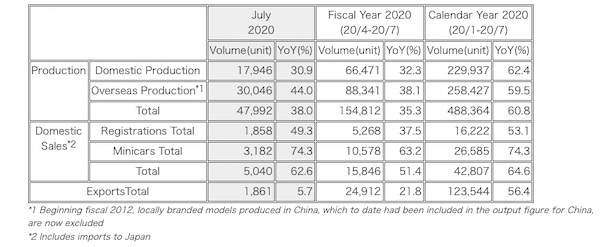Created and wholly owned by Groupe Renault, RCI Banque S.A. is a French bank specializing in automotive financing and services for the customers and dealership networks of Groupe Renault (Renault, Dacia, Alpine, Renault Samsung Motors and Lada) worldwide, the Nissan group (Nissan, Infiniti and Datsun) mainly in Europe, Brazil, Argentina and South Korea and through… Continue reading @Renault: APPOINTMENT TO THE EXECUTIVE COMMITTEE OF RCI BANK…000030
Tag: Mitsubishi
@Mitsubishi: MITSUBISHI MOTORS Opens New Headquarter Showroom “MI-Playground” on September 1, 2020
TOKYO, Aug 31, 2020 – (JCN Newswire) – MITSUBISHI MOTORS CORPORATION (MMC) announced today that it will open its new headquarter showroom, also known as “MI-Playground” (pronounced “My Playground”), near its headquarters in Tamachi, Tokyo, on September 1, 2020. Working in concert with its global brand message “Drive your Ambition,” MITSUBISHI MOTORS is committed to… Continue reading @Mitsubishi: MITSUBISHI MOTORS Opens New Headquarter Showroom “MI-Playground” on September 1, 2020
@Toyota: JAXA and Toyota Announce ‘LUNAR CRUISER’ as Nickname for Manned Pressurized Rover
TOKYO, Aug 28, 2020 – (JCN Newswire) – The Japan Aerospace Exploration Agency (JAXA) and Toyota Motor Corporation (Toyota) announced today that they have named the manned pressurized rover which is currently under joint research by JAXA and Toyota the ‘LUNAR CRUISER’ as ‘nickname’. JAXA and Toyota previously announced and have been conducting joint research… Continue reading @Toyota: JAXA and Toyota Announce ‘LUNAR CRUISER’ as Nickname for Manned Pressurized Rover
@Mitsubishi: MITSUBISHI MOTORS Announces Production, Sales and Export Figures for July 2020
TOKYO, Aug 28, 2020 – (JCN Newswire) – MITSUBISHI MOTORS today announces its production, sales and export figures for July 2020. Summary Domestic Production– Third consecutive monthly year-on-year decrease since April, 2020; 30.9% year-on-year Overseas Production– Ninth consecutive monthly year-on-year decrease since October, 2019; 44.0% year-on-year Total Production– Tenth consecutive monthly year-on-year decrease since September,… Continue reading @Mitsubishi: MITSUBISHI MOTORS Announces Production, Sales and Export Figures for July 2020
Europa Press: Three ‘made in Spain’ models, among the best-selling cars in Europe in July000203
MADRID, Aug 27 (EUROPA PRESS) – The Renault Captur, Peugeot 2008 and Opel / Vauxhall Corsa models, all manufactured in plants installed in Spain, were among the ten best-selling cars on the European market last July, according to data from Jato Dynamics collected by Europa Press . The Renault Captur, which is manufactured in Valladolid,… Continue reading Europa Press: Three ‘made in Spain’ models, among the best-selling cars in Europe in July000203
@Mitsubishi: Mitsubishi Licenses Hybrid Technology Patents from Paice, Abell Foundation
BALTIMORE, MD / ACCESSWIRE, Aug 25, 2020 – (ACN Newswire) – Paice, a pioneer in hybrid electric vehicle technology, announced today that it has reached an agreement to license its patented hybrid technology to MITSUBISHI MOTORS CORPORATION, a global leader in plug-in hybrid vehicles. The Mitsubishi Outlander is the world’s best-selling plug-in hybrid. “Mitsubishi is… Continue reading @Mitsubishi: Mitsubishi Licenses Hybrid Technology Patents from Paice, Abell Foundation
@Daimler: Mercedes-Benz Sprinter: from four factories on three continents for the world
Series Production of the current model of the Sprinter started in March 2018; since September 2019 production network completed First eSprinter left the Düsseldorf assembly line in December 2019 Stuttgart, Germany – The Mercedes-Benz Sprinter has been the success model from Mercedes-Benz Vans for 25 years now, and is a flagship in the van business.… Continue reading @Daimler: Mercedes-Benz Sprinter: from four factories on three continents for the world
@Daimler: Locally CO2-neutral distribution transport for Leipzig: DB Schenker counts on the Mercedes-Benz eActros
First customer of the second test phase in Germany starts practical use of the all-electric Mercedes-Benz eActros DB Schenker delivers to customers in Leipzig city center with the 25-ton eActros The logistics service provider is already gaining experience with another battery-powered model from Daimler Trucks: five light-duty FUSO eCanter trucks are in operation in Germany… Continue reading @Daimler: Locally CO2-neutral distribution transport for Leipzig: DB Schenker counts on the Mercedes-Benz eActros
Carlos Ghosn writes book, plans to detail conspiracy against him – CarAdvice
A tell-all book by the fugitive former car company boss is set to be released by the end of the year. Fugitive and former car company boss Carlos Ghosn has revealed details of his forthcoming book in an interview with Saudi-owned television broadcaster, Al Arabiya. In the 35-minute interview, Ghosn claims that his book reveals… Continue reading Carlos Ghosn writes book, plans to detail conspiracy against him – CarAdvice
SG’s Carro raises $11m from Mitsubishi, MS&AD Ventures, others
In Singapore, we are looking to double our reporting team by this year-end to comprehensively cover the fast-moving world of funded startups and VC, PE & M&A deals. We want reporters who can tell our readers what is really happening in these sectors and why it matters to markets, companies and consumers. The ability to… Continue reading SG’s Carro raises $11m from Mitsubishi, MS&AD Ventures, others

